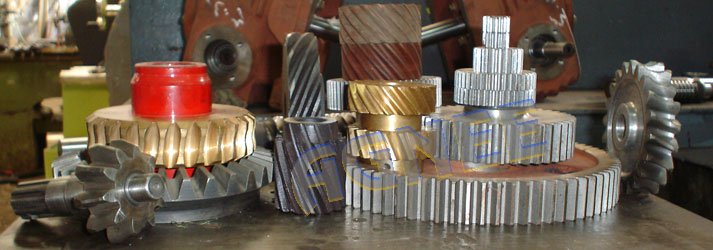 |
|
 |
|
Spur Gears
|
|
 |
|
A SPUR GEAR is cylindrical in shape, with teeth on
the outer circumference that are straight and parallel to the axis (hole). These
are the most common type of gears. Sometimes, many spur gears are used at once
to create very large gear reductions. These gears can only mesh correctly if
they are fitted to parallel axles. Their advantages are simplicity in design,
economical to manufacture and absence of end thrust on bearings. They impose
only radial loads on the bearings. These are usually known as slow speed gears but
if noise is not a serious design problem, these can be used at almost any speed
which can be handled by either types of gears.
They give lower but satisfactory performance. They
are used when shaft rotates in the same plane. The most usual arrangement of
spur gears is an external gear and pinion combination, but if center
distance is to be reduced, than internal gear and external pinion combination
is used.
|
|
Features:- They have higher contact ratio that makes them smooth and quiet in operation. They
are available for corrosion resistant operation. They are among the most
cost-effective type of gearing. They are also used to create large gear
reductions.
|
| |
Application:- They are used in simple machines like washing machines, clothes dryer
or power winches. They are also used in construction equipment, machine tools,
indexing equipment, multi spindle drives, roller feeds, and conveyors. They are
not used in automobiles because they produce sound when the teeth of both the
gears collide with each other. It also increases stress on the gear teeth. To reduce the noise and stress
in the gears helical gears are used in place of spur gear. |
| |

Internal Gears
|
Internal Gears have their teeth cut parallel to their shafts like
spur gears, but they are cut on the
inside of the gear blank.
|
|
|
There are a number of variations of the basic spur gear, including pinion wire,
stem pinions, racks and internal gears.
|
| |

Pinion Wire |
Pinion Wire is a long wire or rod that has been drawn through a die so that gear teeth are cut into its surface. It can be made
into small gears with different face widths, hubs, and bores.
|

Stem Pinion
|
Stem Pinions are bore-less spur gears with
small numbers of teeth cut on the end of a ground piece of shaft. They are
especially suited as pinions when large reductions are desired.
|

Racks
|
Racks are yet another type of spur gear. Unlike the basic spur gear, racks have
their teeth cut into the surface of a straight bar instead of on the surface of
a cylindrical blank.
|
|
 |
<<back |
 |
|








